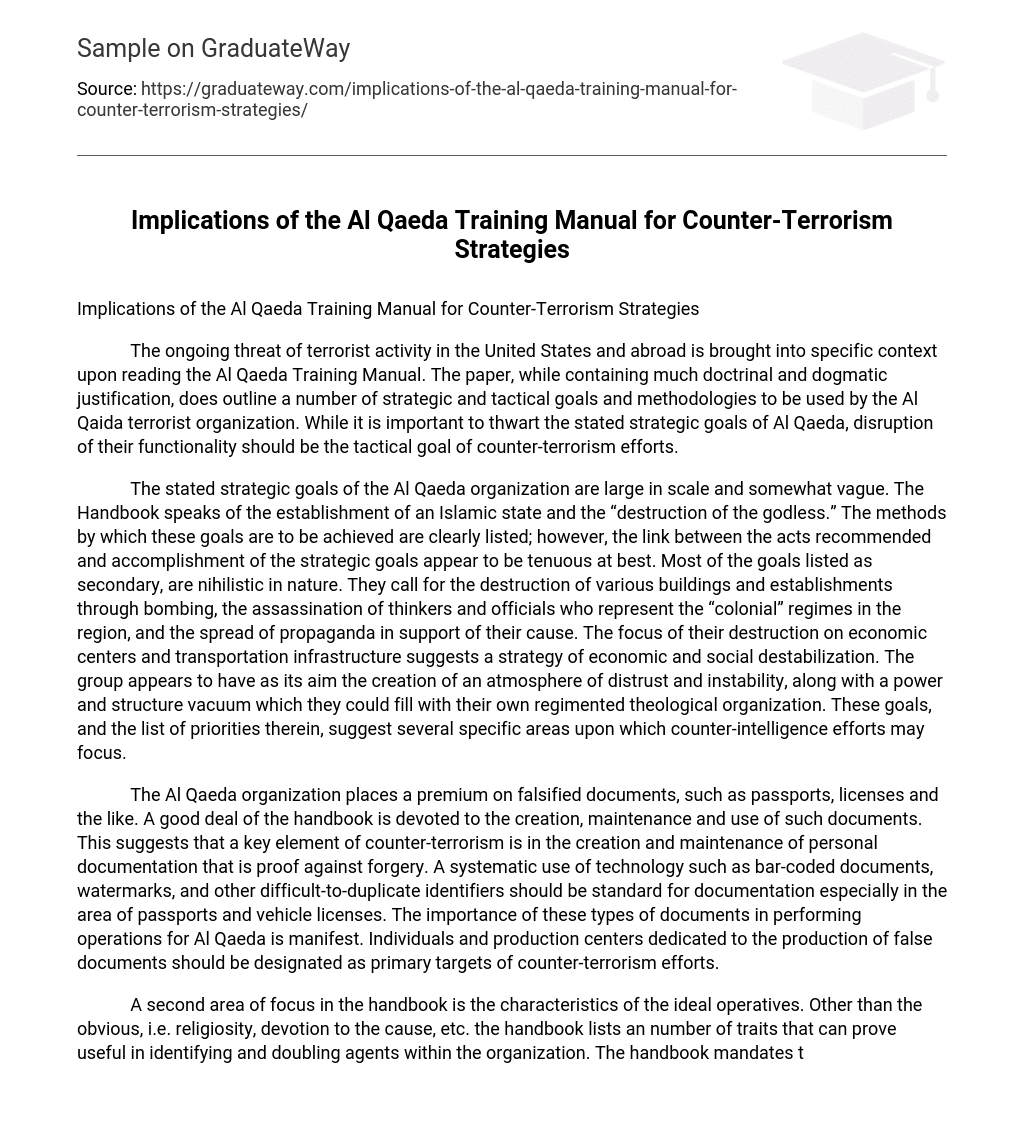The ongoing threat of terrorist activity in the United States and abroad is brought into specific context upon reading the Al Qaeda Training Manual. The paper, while containing much doctrinal and dogmatic justification, does outline a number of strategic and tactical goals and methodologies to be used by the Al Qaida terrorist organization. While it is important to thwart the stated strategic goals of Al Qaeda, disruption of their functionality should be the tactical goal of counter-terrorism efforts.
The stated strategic goals of the Al Qaeda organization are large in scale and somewhat vague. The Handbook speaks of the establishment of an Islamic state and the “destruction of the godless.” The methods by which these goals are to be achieved are clearly listed; however, the link between the acts recommended and accomplishment of the strategic goals appear to be tenuous at best. Most of the goals listed as secondary, are nihilistic in nature. They call for the destruction of various buildings and establishments through bombing, the assassination of thinkers and officials who represent the “colonial” regimes in the region, and the spread of propaganda in support of their cause. The focus of their destruction on economic centers and transportation infrastructure suggests a strategy of economic and social destabilization. The group appears to have as its aim the creation of an atmosphere of distrust and instability, along with a power and structure vacuum which they could fill with their own regimented theological organization. These goals, and the list of priorities therein, suggest several specific areas upon which counter-intelligence efforts may focus.
The Al Qaeda organization places a premium on falsified documents, such as passports, licenses and the like. A good deal of the handbook is devoted to the creation, maintenance and use of such documents. This suggests that a key element of counter-terrorism is in the creation and maintenance of personal documentation that is proof against forgery. A systematic use of technology such as bar-coded documents, watermarks, and other difficult-to-duplicate identifiers should be standard for documentation especially in the area of passports and vehicle licenses. The importance of these types of documents in performing operations for Al Qaeda is manifest. Individuals and production centers dedicated to the production of false documents should be designated as primary targets of counter-terrorism efforts.
A second area of focus in the handbook is the characteristics of the ideal operatives. Other than the obvious, i.e. religiosity, devotion to the cause, etc. the handbook lists an number of traits that can prove useful in identifying and doubling agents within the organization. The handbook mandates that group members be free of illness. A possible target for doubling might be an individual who is otherwise highly qualified and motivated to join the group, but is disqualified on the basis of illness. Such an individual, having been cast out by the organization, could be a vital resource for information and insight about Al Qaeda.
The area of greatest focus in the handbook is military-style organization, recruitment and leadership. This suggests, as has been demonstrated, that the most effective tactical methodology against Al Qaeda is the disruption of the chain of command through elimination of their leaders. Because of the regimented hierarchy, however, regional or level-leaders are relatively easy to replace. Thus, a policy shift in operations is suggested. As primary targets, members of the command structure should be second to technical specialists, particularly in the areas of documents and special weapons. Elimination of those two assets would be the most effective use of military action against Al Qaeda.
References
“The Al Qaeda Manual” (n.d.) Retrieved November 29th, 2008 from the Department of Justice website:
http://www.usdoj.gov/ag/manualpart1_1.pdf
Al-Saheil, T. (2008). “Al-Qaeda’s Ever-Changing Methods Makes Us Expect the Worst- Saudi Official”, Retrieved November 30th, 2008 from Asharq Alawsat website:
http://www.asharqalawsat.com/english/news.asp?section=1;id=13125
Clarke, R. (2001) “Memorandum for Condeleezza Rice: Presidential Policy initiative/Revie: The Al Qida Network” Retrieved November 30th, 2008 from the National Security Archives Website:
http://www.gwu.edu/~nsarchiv/NSAEBB/NSAEBB147/clarke%20memo.pdf
Rice, C. (2004) “Opening Remarks: National Commission on Terrorist Attacks Upon the United States, 9th Open Hearing” Retrieved November 30th, 2008 from the 9-11 Commission website:
http://www.9-11commission.gov/archive/hearing9/9-11Commission_Hearing_2004-04-08.htm
;





